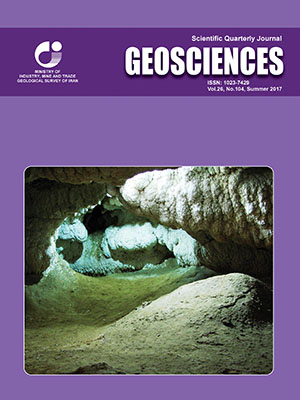References
Aistov, L., Melnikov, B., Kriviyakin, B. and Morozov, L., 1984- Geology of the Khur area (Central Iran). Explanatory text of the Khur Quadrangle Map 1:250,000. Geol. Surv. Of Iran.
Allenbach, P., 1966- Geology and Petrology dese Damavand seiner umgebung (Central Alburz). Iran. Mitt. Geol. Inst. E. T. H. Zurich, N. f., 63: p. 1-144.
Chen, T., Liu, X. M., Zhu, M. Z., Zhao, K. L., Wu, J. J., Xu, J. M. and Huang, P., 2008- Identification of Trace Element Sources and Associated Risk Assessment in Vegetable Soils of the Urban-Rural Transitional Area of Hangzhou, China, Environmental Pollution, Vol. 151, No. 1: p. 67-78.
Christodoulidou, M., Charalambous, C., Aletrari, M., Nicolaidou, K. P., Petronda, A., and Ward, N. I., 2012- Arsenic concentrations in groundwaters of Cyprus. Journal of Hydrology (468-469): 94 - 100.
Davis, J. C., 1986- Statistics and Data Analysis in Geology. Wiley International, New York.
De Temmerman, L., Vanongeval, L., Boon, W., and Hoenig, M., 2003- Heavy metal content of aerable soil in northern Belgium. Water, Air, and Soil Pollution, Vol. 148: p. 61–76.
Devi Onim, J., Ramanathan, A. L., and Singh, G., 2012- Geochemical and Statistical evaluation of groundwater in Imphal and Thoubal district of Manipur, India. Journal of Asian Earth Sciences 48: 136-149.
Diaz, R. V., Aldape, F. and Flores M. J., 2002- Identification of airborne particulate sources, of samples collected in Ticomán, Mexico, using PIXE and multivariate analysis, Nuclear Instruments and Methods in Physics Research Section B: Beam Interactions with Materials and Atoms, Vol. 189, Issues 1–4: p. 249-253.
Everitt, B. S. and Dunn, G., 2001- Applied Multivariate Data Analysis. Oxford University Press, New York, 2nd ed. 342.
Garcia, J. H., Li, W. W., Arimoto, R., Okrasinski, R., Greenlee, J. and Walton, J., 2004- Characterization and implication of potential fugitive dust sources in the Pasodel Norte region. Science of the Total Environment, Vol. 325: PP. 95-112.
Haghipour, A., 1974- Etude geologique de la region de Biabanak – Bafq (Iran - Central); Petrologie ET tectonique du slope Precamberien ET du sa couverture. These, Universite Scientifique ET Medicale de Granoble, France. 403.
Kaufman, L., and Rousseeuw, P. J., 1990- Finding Groups in Data. John Wiley and Sons, Inc., New York. 342.
Kaufman, L., and Rousseeuw, P. J., 2005- Finding Groups in Data. John Wiley and Sons, Inc., New York. 368.
Kelly, J., Thornton, I. and Simpson, P. R., 1996- Urban geochemistry, a study of the influence of anthropogenic activity on the heavy metal content of soils in traditionally industrial and nonindustrial areas of Britain. Applied Geochemistry Vol. 11: p. 363 - 370.
Lee, C. S., Li, X. D., Shi, W. Z., Cheung, C. S. and Thornton, I., 2006- Metal contamination in urban, suburban, and country park soils of Hong Kong: a study based on GIS and multivariate statistics, Sci. Total Environ, Vol. 356: p. 45–61.
Lin, S., Hsieh, I. J., Huang, K. M. and Wang, C. H., 2002- Influence of the Yangtze River and grain size on the spatial variations of heavy metals and organic carbon in the East China Sea continental shelf sediments. Chemical Geology, Vol. 182: p. 377–394.
Loska, K. and Wiechuya, D., 2003- Application of principle component analysis for the estimation of source of heavy metal contamination in surface sediments from the Rybnik Reservoir. Chemo. Vol. 51: p. 723-33.
Miranda, J., Andrade, E., Lo´pez-sua´rez, A., Ledesma, T. R., Cahill, A. and Wakabayashi, P. H., 1996- A receptor model for atmospheric aerosols from a southwestern site in Mexico City. Atmos Environ, 30 (20): p. 3471-3479.
Nowak, B., 1998- Contents and relationship of elements in human hair for a non-industrialized population in Poland. Sci. Total Environ, Vol. 209: p. 59-68.
Qishlaqi, A. and Moore, F., 2007- Statistical analysis of Accumulation and Sources of Heavy Metals Occurrence in Agricultural Soils of Khoshk River Banks, Shiraz, Iran. American-Eurasian Journal Agriculture and Environtal Sciences, 2(5): p. 565-573.
Reimann, C. and DeCaritat, P., 2000- Intrinsic flaws of element enrichment factor (EFs) in environmental geochemistry, Environtal Sciences. Technol., Vol. 34: p. 5084–5091.
Rollinson, H. R., 1993- Using Geochemical Data, Evaluation, Presentation, Interpretation. Longman Scientific and Technical. New York. 352.
Sanford, F., Pierson, T. and Crovelli, R. A., 1993- An Objective Replacement Method for Censored Geochemical Data, Mathematical Geology, and Vol. 25: p. 59 - 79.
Shakeri, A., Moore, F. and Modaberi, S., 2009- Heavy metal contamination and distribution in the Shiraz industrial complex zone soil, South Shiraz, Iran. World Applied Sciences Journal 6(3): p. 413-425.
Shelley, D., 1992- Igneous and Metamorphic Rocks Under the Microscope. Classification, Textures, Microstructures and Mineral Pre- ferred Orientations. London (Chapman and Hall), 445.
Swan, A. R. H., Sandilands, M. and McCabe, P., 1995- Introduction to Geological Data Analysis, Blackwell Science, 446.
Tlili-Zrelli, B., Azaza, F. H., Gueddari, M. and Bouhlila, R., 2012- Geochemistry and quality assessment of groundwater using graphical and multivariate statistical methods. A case study: Grombalia phreatic aquifer (Northeastern Tunisia). Arabian Journal of Geosciences 6: p. 3545-3561.
Torabi, G., 2011- Late Permian blueschist from Anarak ophiolite (Central Iran, Isfahan province), a mark of multi-suture closure of the Paleo-Tethys ocean. Revista Mexicana de Ciencias Geológicas, 28(3): 544-554.
Wilmsen, M., Fürsich, F. T., Majidifard, M. R., 2015- An overview of the Cretaceous stratigraphy and facies development of the Yazd Block, western Central Iran/ Journal of Asian Earth Sciences 102, p. 73–91.
Zhang, A. Y., 2012- Evidence on the tradeoff between real activities manipulation and accrualbasedearnings management. The Accounting Review87 (2): p. 675-703.

